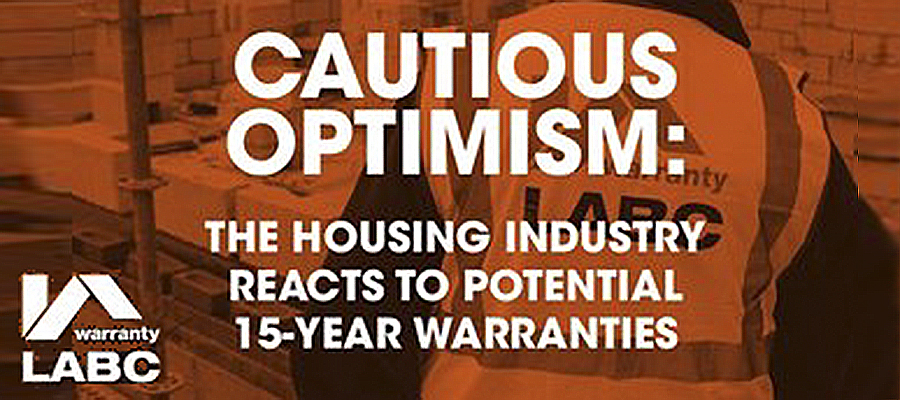Mandatory 15 year warranties on new homes supported with caution
An LABC Warranty survey has found that while the majority of those in the housing industry are unaware of the potential for minimum 15-year structural warranties to be introduced by law, they are optimistic about the effects of that change.
The Building Safety Act, introduced in April 2022, brings generational change to the UK's construction industry. The Act introduces new regulations, enforcement mechanisms regulatory bodies, and enhanced powers for these regulators.
Significantly, it also includes provisions that will make structural warranties legally mandatory for the first time.
The survey, which drew responses from housebuilders and developers, designers, building control professionals, consultants, contractors, self-build, social housing provider, and homeowners focused on two aspects of the proposed legislation:
Minimum 15-year warranties. The legislation, if triggered by secondary regulations, would establish a new standard of 15-year minimum coverage for structural warranties. Currently, most warranties span 10 years, with certain exceptions.
All new-home coverage. The new legislation, if activated, would also make it mandatory for all new-build homes to be covered by a structural warranty. Presently, no statutory requirement mandates warranty coverage for new build homes.
LABC Warranty's survey set out to discover the awareness level for the above legislative changes, and the level of support these changes have among existing structural warranty customers and readers of their technical content.
The survey shows that:
- 64% of respondents were unaware of the proposal to extend the standard 10/12-year warranty term to 15 years.
- 53% were unaware of a proposal to make warranty cover a legal requirement for all new homes.
Despite this:
- 60% of respondents are in favour of extending warranties from 10/12 years to 15 years.
- 58% believe mandating warranties would lead to better standards of safety, or improved customer satisfaction.
- Overall, 40% believed there would be a positive outcome if all warranty-related secondary legislation came into force, 23% believed it would lead to a negative outcome, and 37% believed it would lead to a mixed result.
Only 5% of respondents said they had prepared for the secondary legislation to be enacted.
Reasons in support of longer warranty periods included improved standards (46%), better protection for homeowners (41%) and alignment with the Defective Premises Act liability period (10%). Lack of need (56%) and increased cost (37%) were the main reasons for those against.
Building control practitioners were most in support of the extended term (92%) while housebuilders/developers were most against (67%).
LABC Warranty commented: "Even respondents who offered a broadly positive outlook had reservations about potential negative effects of the legislative changes discussed. Given this and the strength of feeling shown through comments, LABC Warranty would describe the response as a very cautious optimism while we await more details on any upcoming secondary legislation."
This article appears on the CIAT news and blogsite as "Industry 'cautiously supports' mandatory 15-year warranties on new homes" dated September 12, 2023.
--CIAT
[edit] Related articles on Designing Buildings
- Agency.
- Bonds.
- Bonds v guarantees.
- Breach of contract.
- Building Safety Act.
- Building safety bill.
- CIAT raises concerns about Building Safety Bill.
- CIOB responds to Newsnight report - Trapped: the UK's building safety crisis.
- CIOB reviews the Building Safety Bill.
- Collateral warranties.
- Defects.
- Definition of collateral warranty.
- Difference between collateral warranties and third party rights.
- Duty.
- Fire safety bill.
- Fit for purpose.
- Golden thread.
- Grenfell Tower fire.
- Grenfell Tower Inquiry.
- Guarantees.
- Hackitt Review.
- Insurance.
- Miller Act.
- Performance bond.
- Practical considerations of collateral warranties.
- Professional consultant's certificate.
- Reasonable skill and care.
- The Building Safety Bill and product testing.
- The Building Safety Bill - A Quality Response.
- The Building Safety Bill, regulations and competence.
- The golden thread and BS 8644-1
- Warranty.
Featured articles and news
CIOB report; a blueprint for SDGs and the built environment
Pairing the Sustainable Development Goals with projects.
Latest Build UK Building Safety Regime explainer published
Key elements in one short, now updated document.
UKGBC launch the UK Climate Resilience Roadmap
First guidance of its kind on direct climate impacts for the built environment and how it can adapt.
CLC Health, Safety and Wellbeing Strategy 2025
Launched by the Minister for Industry to look at fatalities on site, improving mental health and other issues.
One of the most impressive Victorian architects. Book review.
Common Assessment Standard now with building safety
New CAS update now includes mandatory building safety questions.
RTPI leader to become new CIOB Chief Executive Officer
Dr Victoria Hills MRTPI, FICE to take over after Caroline Gumble’s departure.
Social and affordable housing, a long term plan for delivery
The “Delivering a Decade of Renewal for Social and Affordable Housing” strategy sets out future path.
A change to adoptive architecture
Effects of global weather warming on architectural detailing, material choice and human interaction.
The proposed publicly owned and backed subsidiary of Homes England, to facilitate new homes.
How big is the problem and what can we do to mitigate the effects?
Overheating guidance and tools for building designers
A number of cool guides to help with the heat.
The UK's Modern Industrial Strategy: A 10 year plan
Previous consultation criticism, current key elements and general support with some persisting reservations.
Building Safety Regulator reforms
New roles, new staff and a new fast track service pave the way for a single construction regulator.
Architectural Technologist CPDs and Communications
CIAT CPD… and how you can do it!
Cooling centres and cool spaces
Managing extreme heat in cities by directing the public to places for heat stress relief and water sources.
Winter gardens: A brief history and warm variations
Extending the season with glass in different forms and terms.
Restoring Great Yarmouth's Winter Gardens
Transforming one of the least sustainable constructions imaginable.

























